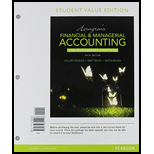
1.
Statement of
Cash flows from operating activities: These are the cash produced by the normal business operations.
Indirect method: Under this method, the following amounts are to be adjusted from the Net Income to calculate the net cash provided from operating activities.
The below table shows the way of calculation of cash flows from operating activities:
| Cash flows from operating activities (Indirect method) |
| Add: Decrease in current assets |
| Increase in current liability |
|
|
| Loss on sale of plant assets |
| Deduct: Increase in current assets |
| Decrease in current liabilities |
| Gain on sale of plant assets |
| Net cash provided from or used by operating activities |
Cash flows from investing activities: Cash provided by or used in investing activities is a section of statement of cash flows. It includes the purchase or sale of equipment or land, or marketable securities, which is used for business operations.
| Cash flows from investing activities |
| Add: Proceeds from sale of fixed assets |
| Sale of marketable securities / investments |
| Interest received |
| Dividend received |
| Deduct: Purchase of fixed assets/long-lived assets |
| Purchase of marketable securities |
| Net cash provided from or used by investing activities |
Cash flows from financing activities: Cash provided by or used in financing activities is a section of statement of cash flows. It includes raising cash from long-term debt or payment of long-term debt, which is used for business operations.
| Cash flows from financing activities |
| Add: Issuance of common stock |
| Proceeds from borrowings |
| Proceeds from issuance of debt |
| Deduct: Payment of dividend |
| Repayment of debt |
| Interest paid |
| Redemption of debt |
|
Purchase of |
| Net cash provided from or used by financing activities |
Non-Cash Transaction:
The transaction, which does not involve any cash dealings, is known as non-cash transactions. In these type transactions there will not be any inflow or outflow of cash. Simply put, the transaction, which does not have an impact on the inflow or outflow of cash, is called as non-cash transactions.
Examples of significant non-cash transactions are stated below:
- Issue of common stock to retire long-term debt.
- Purchase of machinery by issuing notes payable
- Issuance of common stock for purchase of land
To Prepare: Statement of cash flows for the year 2016 (Using indirect method).
2.
To Analyze: The statement of cash flows to get help for evaluating an investment.
Want to see the full answer?
Check out a sample textbook solution
Chapter 14 Solutions
Horngren's Financial & Managerial Accounting, The Managerial Chapters, Student Value Edition Plus MyLab Accounting with Pearson eText -- Access Card Package (5th Edition)
- A business purchased a machine that had a total cost of $300,000 and a residual value of $30,000. The asset is expected to service the business for a period of 8 years or produce a total of 800,000 units. The machine was purchased on January 1st of the current year and has been in service for one complete year. What is the depreciable cost of the asset? A. $270,000 B. $300,000 C. $30,000 D. $250,000arrow_forwardNeed answerarrow_forwardQuestion: Mr. R bought a machine for Rs 25,000 on which he spent Rs 5,000 for carriage and freight; Rs 1,000 for brokerage of the middleman; Rs 3,500 for installation and Rs 500 for an iron pad. The machine is depreciated @ 10% every year on a written down basis. After three years the machine was sold to Mr. B for Rs 30,500 and Rs 500 was paid as commission to the broker. Find out the profit or loss on the sale of the machine. No wrong answerarrow_forward
- On January 1, Trump Financial Services lends a corporate client $180,000 at an 8% interest rate. The amount of interest revenue that should be recorded for the quarter ending March 31 equals:arrow_forwardRDX Corporation's production budget for September is 22,000 units and includes the following component unit costs: direct materials, $7.50; direct labor, $12.00; variable overhead, $6.20. Budgeted fixed overhead is $55,000. Actual production in September was 23,400 units, actual unit component costs incurred during September include direct materials, $8.10; direct labor, $11.80; variable overhead, $6.50. Actual fixed overhead was $57,000, the standard fixed overhead application rate per unit consists of $2.50 per machine hour and each unit is allowed a standard of 1.2 hours of machine time. Calculate the fixed overhead budget variance.arrow_forwardRIO is a retailer of smart televisions. Typically, the company purchases atelevision for $1,200 and sells it for $1,500. What is the gross profit margin on this television? Correct Answerarrow_forward
- Suppose Harbor view Hotel has annual fixed costs applicable to its rooms of $2.5 million for its 350-room hotel. Average daily room rents are $60 per room, and average variable costs are $15 for each room rented. It operates 365 days per year. If the hotel is completely full throughout the year, what is the net income for one year? Don't Use Aiarrow_forwardHi experts please answer the financial accounting questionarrow_forwardRIO is a retailer of smart televisions. Typically, the company purchases atelevision for $1,200 and sells it for $1,500. What is the gross profit margin on this television?arrow_forward
 Financial Accounting: The Impact on Decision Make...AccountingISBN:9781305654174Author:Gary A. Porter, Curtis L. NortonPublisher:Cengage Learning
Financial Accounting: The Impact on Decision Make...AccountingISBN:9781305654174Author:Gary A. Porter, Curtis L. NortonPublisher:Cengage Learning
